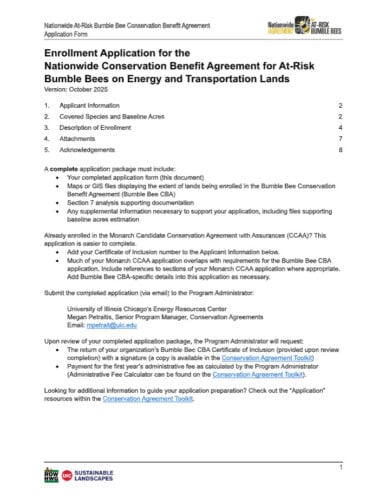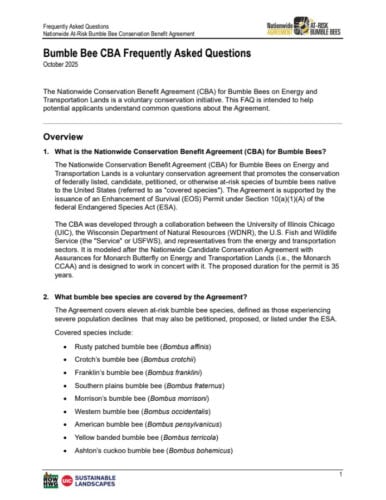
The purpose of this toolkit is to support interested applicants and enrolled partners participating in the Nationwide Monarch Butterfly Candidate Conservation Agreement for Energy and Transportation Lands (CCAA) and the Conservation Benefit Agreement for Bumble Bees (CBA).
The tools and guidelines linked here were developed to aid organizations in consistent and effective implementation of the CCAA and CBA. This toolkit also provides a place to find best practices and other resources developed collaboratively or sourced from across the CCAA and CBA partner network.
Liability for the implementation of the CCAA or CBA, or any use made of these implementation resources by its partners, is the sole responsibility of the partner itself. None of the authors, contributors, administrators, or anyone else connected with the CCAA or CBA, in any way whatsoever, can be responsible for your use of the information contained in or linked in these resources.

Conservation Agreements
This tool allows Monarch CCAA Partners to submit their annual compliance report. To access the tool, log into the Rights-of-Way as Habitat Working Group website using the username and password provided by the Program Administrator.

Conservation Agreements
This presentation provides a high-level overview of the Bumble Bee CBA for leadership teams considering enrollment in the agreement.

Conservation Agreements
A single-slide overview introducing the Bumble Bee CBA for use in leadership briefings or presentations.

Conservation Agreements
This document provides an overview of the Suitable Habitat Idle Lands, or Set-Asides conservation measure, including acceptable approaches for CCAA implementation.

Conservation Agreements
This application outlines the information required for enrollment in the Bumble Bee CBA for both current Monarch CCAA partners and new organizations.

Conservation Agreements
This document provides a list of frequently asked questions about the Bumble Bee CBA, offering quick reference information on its background, enrollment process, conservation requirements, regulatory benefits, and more.

